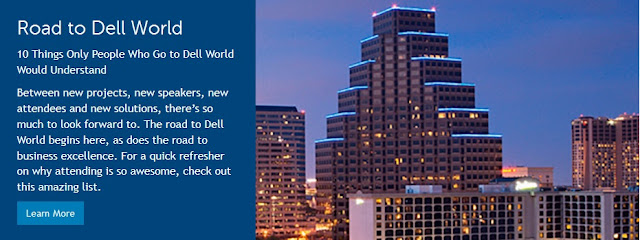On Tuesday, October 6
th, the European Court of Justice (ECJ),
invalidated the U.S./EU Safe Harbor Framework.
This framework, in place since 2000, gave blanket permission to data
transfers from the European Union to the United States. The ruling means
that national data protection authorities can now review such data
transfers on an individual basis. It also complicates many aspects of
data security for any enterprises doing business across the Atlantic
Ocean.
This recent ruling highlights the value of having a strong security
partner shepherding your enterprise through these types of
perturbations. Luckily during
Dell Peak Performance in Las Vegas, I had the opportunity to discuss the importance of such a partnership with
Bill Evans, senior director of product marketing for Dell’s Identity and Access Management businesses.
Photo courtesy of Bill Evans
Kevin: Bill, thank you joining use today. What is your role at Dell?
Bill: Thank you for the invitation, Kevin. I work in
the product marketing group within Dell Security. Specifically I
support the Identity and Access Management product portfolio.
Kevin: Identity and Access Management is a very important aspect of
cloud security.
What has changed in the IDAM (identity and access management)
marketplace over the past 12 months? The proliferation of devices seems
to be the Achilles heel to having secure IT.
Bill: Historically, when it came to IT, everything
was centralized. The mainframe, the client-server model and desktop
computers were all contained within a company’s network perimeter. That
perimeter is now gone and organizations are now trying to deal with an
IT world that has no boundaries. A recent analyst report actually stated
that identity is now the new perimeter. Protecting the network from
intrusion, malware and other threats is still as important as ever.
Additionally though, companies need to work harder to control access to
data and applications. The focus is not only on outside hackers trying
to get in but on the malicious insider as well.
Kevin: With identity and access management as the
new boundary for now and into the foreseeable future, how do your
customers step up to this formidable challenge?
Bill: Above all, leaders and managers need to be
intelligent about the investments they make in this area. This also
means avoiding reflexive “knee-jerk” reactions. The first step of the
process is conducting an inventory of their current infrastructure. It’s
actually impossible to protect every piece of data and frankly, they
don’t need to waste money and effort trying to do so. Companies do,
however, need to categorize and strongly protect data that is important.
Things like personally identifiable information (PII) or healthcare
records need to be isolated and surrounded with strong access controls.
We call this process prioritizing the need which means developing plans
that protect the most sensitive data by using the strongest
operationally practical protections. Organizations are then in a
position to assess available tools for implementing the needed
protections. Dell’s portfolio not only provides solutions for today’s
problems, but it also delivers a platform that can address future needs
and challenges. Security is not a one-time project so we partner with
our customers over the long haul. Making intelligent business decisions
across all available technologies is key.
Kevin: You’ve outlined an approach that includes
infrastructure deployment decisions in combination with a sort of data
triage process. I’ve also been impressed with the breadth and depth of
Dell’s security portfolio. With that said, what issues are top of mind
for you and the Dell security team. Which of these issues are you
planning to address over the next twelve months?
Bill: That’s really a great question. The thing
we’re looking at very closely right now is the impact that security has
on user productivity. To be honest, on a scale from one to 10, a
security and risk professional wants to turn the security dial up to 11.
They want to secure everything with multiple credentials that all have
very long passwords. Users don’t tend to like that approach, so if you
go down that implementation path, people will generally avoid the issue
by going around what they perceive as a “security hurdle”. This isn’t
good for anybody, including the company.
So what we’re doing is applying some new technology that we refer to
as the Dell Security Analytics Engine. Though the use of Dell’s uniquely
broad security portfolio, the security analytics engine can enable
context-aware security. This capability collects data in real-time from
multiple security assets deployed across an enterprise. We can pull
information from the Dell laptop as a managed or unmanaged device. We
also extract data from the Sonicwall firewall on who is accessing what
type of data from where. Data from Dell Secureworks also compares the
scenario with blacklists and known threat signatures. All this
information is then combined to deliver a
context derived risk score to the
Dell One Identity Cloud Access Manager. The access manager can then make a real-time decision on that connection.
Let me give you an example. If I log in on a Monday morning at 8:30
a.m. from the office with correct credentials, it’s a pretty safe bet
that I am who I claim to be. On the other hand, this week I’m in Las
Vegas at Peak Performance and will probably log in from my hotel room
tonight at 9:00 p.m. The security analytic engine would flag that as
being an unusual occurrence and Cloud Access Manager would interpret the
higher risk score as a cue for stepping up authentication requirements.
This, for instance, may mean using a one-time authentication token. If
my credentials were subsequently used to login at on a Sunday at 2 a.m.
from North Korea, the system would read that as a probable attack and
block the transaction. The challenge is in finding that right balance
between tight security and user productivity. Nine times out of 10,
username and password is good enough. That tenth time, however, a little
extra precaution is warranted. Users are generally willing to accept a
security related inconvenience every once in a while so they won’t try
to circumvent the controls. So in effect, the security team can adjust
the security dials in real time.

Kevin: This seems to be a more balanced approach to
security. At Dell Peak Performance we heard that enterprises have
suffered over $600B in cybersecurity losses this year against just a
$200B investment to protect against these losses. That doesn’t sound
like a balance at all. What should senior decision makers and IT
professionals learn from this statistic?
Bill: This really indicates how tough security
decisions can be. While enterprises today are spending more money on
security, they are also feeling worse about their security posture.
Knee-jerk reactions contribute to this dichotomy. Executives, with the
best of intentions but focused on addressing singular security issues,
serially purchase disparate security products. These types of actions
eventually lead to a patchwork of siloed security solutions. Between
each of these perfectly effective solutions, however, you will find
security gaps through which threats can invalidate a security strategy.
As discussed earlier, we strongly recommend targeting a long-term goal
with the understanding that the company cannot solve every security
problem in one day. Success in this game requires partnering with a
vendor that can not only address today’s issues, but also work with you
to leverage a coordinated investments over time.
Kevin: With respect to identity and access
management, are any specific industry verticals better positioned for
this type of balanced approach? Are there any industry specific insights
that you can share with us?
Bill: There is an interesting dynamic in play when
it comes to user behavior and industry related expectations. While no
one industry is easier or harder when it comes to data protection, they
all have specific requirements related to their industry’s business
model. While the requirements within industries like banking and finance
are certainly different than those in healthcare, they all deal with
the challenge of balancing security with the desired consumer community
experience. In private, management will demand two-factor authentication
throughout their respective user communities, but why hasn’t this
proven control been broadly implemented? Multifactor authentication
isn’t being widely used in the consumer space because of its intrusive
impact on the consumer experience. A prospective customer’s decision to
bank with Company A or Company B may ultimately be driven by how easy it
is to get account information through a smartphone application. Daily
decisions of this type forces a constant balancing between security and
business needs. As consumers, we decide with our buying actions whether
to accept the cost of improved security. Eventually, those same
consumers will need to stand-up and state through their buying actions a
willingness to pay for more robust security. We advise organizations to
act smart by optionally offering enhanced security, now, because over
time, all organizations will be moving in that direction.
Kevin: Do you have any final recommendations for the CEO dealing with this dilemma?
Bill: I would counsel all CEOs to start with
research. You need to understand your infrastructure, thoroughly
understand your threats and attack surfaces and plan for the long term.
This will pay high dividends when selecting a security partner that can
serve your needs as they morph and change over the long haul.
Kevin: Thank you, Bill, for your words of wisdom.
Bill: You’re welcome Kevin.
This post was written as part of the Dell Insight Partners
program, which provides news and analysis about the evolving world of
tech. Dell sponsored this article, but the opinions are my own and don’t
necessarily represent Dell’s positions or strategies.
(
Thank you. If you enjoyed this article,
get free updates by email or RSS - © Copyright Kevin L. Jackson 2015)





















